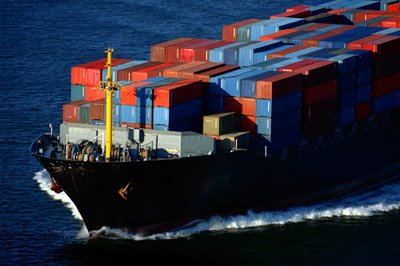ElectriPlast - Balancing Security and Commerce

Security in
a Smaller
World
By Vince S.
ElectriPlast Blog Editor
Of all the vexing and compelling quandaries facing the Department of Homeland Security (DHS) since the terrorist attacks of September 11, 2001--Hurricane Katrina notwithstanding--the most intractable issue is U.S. seaport security.
In an era of globalization and international trade, millions of cargo containers are either being loaded, in transit or being unloaded at the world's major ports each year. In fact, these tractor-trailer sized metal boxes ply the sea lanes stacked five high on the decks of transport ships.
By one statistic, sea borne cargo containers visit the world's ports some 48 million times each year, making about 6 million dockings at U.S. ports. Because of the increasing trade imbalance with Pacific Rim nations, notably China and Japan, most of the cargo containers are destined for the West Coast ports of Los Angeles, Long Beach, Oakland, and Seattle. They represent a staggering 11,000 containers per day or a jaw dropping eight containers per minute.
High volume plus low inspection rate equals high threat level
This incredible volume of cargo containers (only about two per cent of which are inspected by U.S. Customs and Border Protection at U.S. ports), present a very high threat level for DHS and grave concerns in the Oval Office, Capitol Hill and the Pentagon. It understates reality to say that these concerns evolve around our vulnerability and our openness to a terrorist attack
In one scenario played out at the highest levels of the U.S. Government, a cargo container from a furniture maker in the Far East is packed, sealed and manifested for delivery to a national merchandiser in the U.S. For all intents and purposes, the container appears legitimate: It's outer walls are marked by a unique container code that identifies the container owner. But, while waiting on a dock for clearance and shipment, someone surreptitiously enters the container and places a nuclear, biological, or chemical weapon inside set to detonate in two weeks or whatever the transit time is to America.
Unbeknownst to the ship's crew and U.S. port authorities, a ticking time bomb is making its way to our shores.
How can we prevent this from becoming a reality?
On the extreme opposite end of this scenario, Customs and Border Protection decides to inspect each container before it arrives at the U.S. port of entry.
Unfortunately, the backlog of container ships quickly clog the sea lanes for hundreds of miles into the Pacific. Also, the continuous supply-chain that stretches from Beijing to Boston, Guangzhou to Green Bay or Shanghai to Shreveport would grind to a halt and cripple international commerce.
Chaos would ensue, globalization and international trade would be devastated and a tsunami of economic decline would ripple around the globe.
Enter Integral Technologies!
However, against the foregoing catastrophic backdrops, Integral Technologies, through its ElectriPlast intellectual property, has developed a solution.
In a recent U.S. Patent Application (q.v. 0050195101) for a Shipping Container Security System, the patent Abstract described a security system that senses intrusions into a shipping container through the opening of doors, cutting an opening, or removing the doors from their hinges. Moreover, in paragraph [0047] of the patent application, the inventors said, "The antenna is preferably a 'Plastenna' model manufactured by Integral Technologies, Inc. located in Bellingham, Wash."

Six Degrees of Separation Redux
Last week, Starbucks announced that it would install a GE security system called "CommerceGuard" to detect tampering with its cargo containers that carry coffee beans from Guatemala to Starbucks roasting plants in Kent, WA. Starbucks also announced that they had participated in a several year DHS study of cargo container security.
The "CommerceGuard" security system is manufactured by GE-Interlogix in North Saint Paul, MN. When it is rolled out, it could bridge the concerns raised by proponents of homeland security and international commerce.
With these latest revelations, it would appear that Integral Technologies is firmly anchored at the intersection of disruptive technology, homeland security and international commerce.
Reference Material:
http://www.dhs.gov/interweb/assetlibrary/OIG_05-10_Jan05.pdf
http://www.bradenton.com/mld/bradenton/business/14117008.htm
http://electriplast.blogspot.com/2006/02/electriplast-six-degrees-of-separation.html
http://electriplast.blogspot.com/2006/03/electriplast-role-in-asset-tracking.html
http://www.freshpatents.com/Shipping-container-security-system-dt20050908ptan20050195101.php?type=description
http://www.itkg.net








3 Comments:
Today the show Modern Marvels on the History Channel here in the USA had a program about shipping containers. In the program they talked about and displayed the "CommerceGuard" system and how it is used on the containers. I could see the name on one device along with GE's branding.
Here is a link to this Program
http://www.historychannel.com/modernmarvels/?page=upcoming
It's great to see a bit of validation in the real world. I'll attempt to contact both the company behind CommerceGuard, and the History Channel producers to see if there are additional nuggets of information to ferret out...
Cheers and thank you for the heads up -- The history channel here is focused solely on European fare...
Now you've made me nostalgic for a bit of Apple Pie USA...
PK sends...
Post a Comment
<< Home